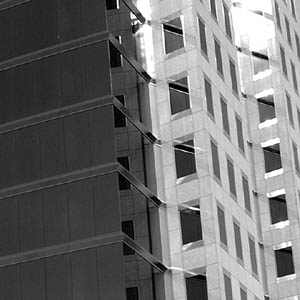![[Metroactive Features]](http://metroactive.com/features/gifs/feat468.gif)
[ Features Index | Silicon Valley | Metroactive Home | Archives ]
Notes From the Underbelly
Plural of City Hall
By Eric A. Carlson
ON LEONARD McKAY'S last day of business at Memorabilia of San Jose (Dec. 31, 2002), I stopped in and purchased a fine old photograph of Old City Hall, a structure that once loomed where the Plaza de Cesar E. Chavez fountain now spouts geyserlets, across from the Fairmont Hotel. A ghastly and imposing Germanic edifice it was. The building was razed in 1958, leaving only the cornerstone, an obstinate reminder at the edge of the plaza the size of a small chair (it was removed several years ago). In fact, there was a City Hall before Old City Hall: Oldest City Call. This is the kind of information that might impress a date, so I will elaborate.
Oldest City Hall was erected at 35 N. Market St. in 1855, five years after muddy San Jose was incorporated. It was a two-story structure, 68 feet long and 42 feet wide, and cost in excess of $8,000. Levi Goodrich, the architect, designed it to resemble a medieval castle with parapets and towers. It would serve as City Hall until 1887, when the aforementioned Old City Hall raised its hideous head in the park. Clyde Arbuckle's History of San Jose provides a description of Oldest City Hall's demise: "It was serving as a firehouse when the 1906 earthquake damaged it beyond repair." Which brings us to Old City Hall.
Old City Hall, as stated above, was built in the middle of the Plaza. (The Plaza soon became known as City Hall Park.) Old City Hall was designed by Theodore Lenzen in 1887 and cost $139,482. The City Council stipulated that no Chinese labor should be used. As for the style of architecture, the American Institute of Architects summed it up thusly: "A design importation, reflecting a very bad period of German architecture. It is not typical of any period of design, and it is not a reflection of the art and culture of the community."
The term "bastard baroque" was applied to it, and a nonfunctioning Victorian cupola topped it off perfectly. The ground floor of City Hall was the city jail and sported a drive-through entrance. Cellblocks were on the south side, and the drunk tank, described by San Jose historian Harry Farrell as "malodorous from seven decades of boozy sweat, vomit, urine and Lysol," was on the north. Prisoners would scrape tin cups against the bars, disturbing the monkey business of council meetings on the floor above. It was demolished in 1958, despite the protestations of citizens, who had fallen in love with it as if it were the family dog--old, flea-bitten, but lovable.
Current City Hall was built in 1958 on a broccoli and cauliflower field near North First Street for just over $6 million. The move away from downtown was viewed as detrimental to downtown, and in 1966, City Manager A.P. "Dutch" Hamann proposed selling the building to the county so that City Hall could move back downtown to a cozy 15-story building. Alas, voters were tired of spending money on moving City Hall and said no. Which brings us almost up-to-date, which is moving City Hall back downtown. Where all the lights are bright.
New City Hall is currently a pit at the edge of Santa Clara Avenue between Fourth and Sixth streets. Pile driving is in process. San Jose politicos maintain the building will cost no more than $343 million, or they will eat their hats and make up for the rest out of their allowances. The design is by world-renowned architect Richard Meier and features a tower with a connected rotunda (dome) and public space that includes a ramp that will prove irresistible to skateboarders. The tower design appears to be just as grotesque, in its own way, as Old City Hall or Oldest City Hall. The architectural style of New City Hall is called postmodern.
Almost City Hall Final Note: The photo is of the facade of the brand-new Sobrato building on Almaden Boulevard--a failed contender for New City Hall, despite being next door to the incomparable Kukar's House of Pizza. The Sobrato is shimmering, elegant and blue. (The Fourth Street Garage has panache as well, as does the emerging joint San Jose/San Jose State University library.)
[ Silicon Valley | Metroactive Home | Archives ]
Copyright © Metro Publishing Inc. Metroactive is affiliated with the Boulevards Network.
For more information about the San Jose/Silicon Valley area, visit sanjose.com.
![]()

Photograph by Eric Carlson
"There isn't room in this chateau for all of us."
--Joe Millionaire's Butler
Send a letter to the editor about this story to letters@metronews.com.
From the January 16-22, 2003 issue of Metro, Silicon Valley's Weekly Newspaper.